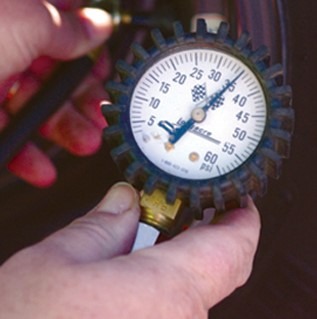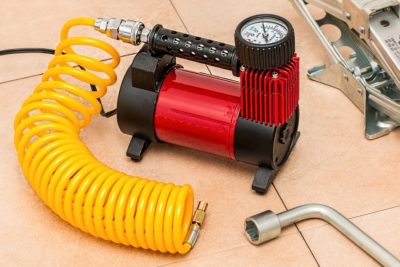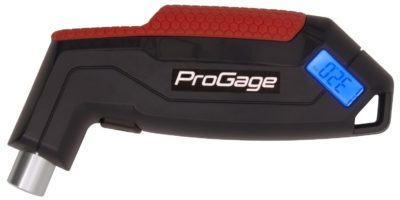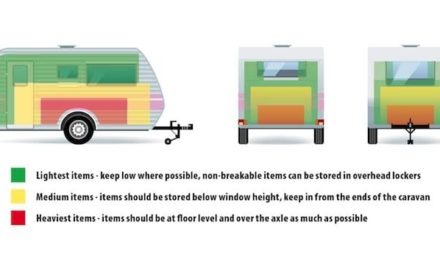Disclosure: When you click on links to various merchants on this site and make a purchase, this can result in this site earning a commission. Affiliate programs and affiliations include, but are not limited to, the eBay Partner Network
I was getting confused by those tyre pressure charts, and it got me wondering: is there a simpler way to find out what caravan tyre pressure should I use?
After a bit of research, I found this:
Your ideal caravan tyre pressure is when there’s a 4 psi increase between when your tyres are cold and when they’ve warmed up from towing. If the increase is less than 4 psi then your tyre pressure is too high… and if it’s by more than 4 psi then you started too low. If you’re using Light Truck (LT) tyres then this number changes to 6 psi.
How to work out the correct tyre pressure for your caravan [step-by-step]
Two identical caravans might have the same tyres on them… but need different tyre pressures.
This is because of things like how much weight you’re carrying and how your caravan is loaded when you’re towing it.
So here’s how you work out the correct tyre pressure for your van:
- Inflate your caravan’s tyres to the cold tyre pressure that’s found on your van’s compliance plate or user manual
- Tow your caravan for 30-60 mins at highway speeds
- Check your van’s tyre pressure again to see how much it changed (it should be 4 psi higher)
- Let the van’s tyres cool down (e.g. overnight)
- If the the change was less than 4 psi this means the starting pressure was too high… so let out 2 psi. Or vice-versa.
- Repeat the test again until you’ve got it to a 4 psi increase
So yes, it might take a trip or two to get it sorted.

It’s totally worth it. Because having the wrong tyre pressure can be both costly and unsafe.
Here’s why:
What happens if my caravan tyre pressure is too high?
If your caravan tyre pressures are too high, then there’s 4 main problems that can happen when you’re towing.
1. Increased risk of punctures
When you tyre pressure is too high, the tyres are more rigid and have less give in them. This means that you’re more prone to punctures from things like sharp rocks (especially if you’re driving on dirt roads).
2. An uncomfortable bumpy ride
If the tyres are pumped up too high, there’s less give and you can be bouncing down the road. This can mean that it’s uncomfortable because you feel the jolts as you go over every bump or pot hole.
But the main thing is it can quickly lead to a caravan that’s…
3. Increased wear-and-tear in the centre of the tyres
When a tyre is over inflated it creates uneven tread wear. There’s a smaller contact area with the road as the outer tread rounds out. It causes the centre of the tyre to wear out more quickly.
4. Hard to control and increase risk of sway
When the tyres are over inflated you’ve got less surcface area in contact with the road. Combine this with the bouncing over bumps and potholes… and you’ve got an increased risk of the wheels losing traction. Or contact altogether.
Combine this with a truck whooshing past, a side wind, and some Jerry cans on the rear bumper… it can go pear shaped pretty quickly.
What happens if my caravan tyre pressure is too low?
Having tyre pressure too low can also lead a problems. Under inflated tyres are one of the most common causes of tyre failure (e.g. blowouts).
1. Increased wear-and-tear on the edges and side walls
When a tyre is under inflated it’s flatter (even if you can’t visibly see it). This means there’s more of it contact with the road. The tyre’s edges will wear out quicker than they’re designed to…. and the side walls are getting more stressed.
2. Worse fuel consumption
Tyres that are under pressure have more surface in contact with the road. Your vehicle has to work harder against the increased rolling resistance.
Pretty much:
Your car has to work harder to do the same job… so it uses more fuel.
What’s the best way to monitor caravan tyre pressure?
Tyre pressure that is too high or too low can be bad. So it’s worth getting it right. And checking regularly.
Getting your tyre pressure right relies on being able to check your tyres when they’re cold… this is why you can’t rely on the gauges at petrol stations
If you drive to a petrol station to do this, your tyres are no longer cold. Unless you live next door

So the best option is to:
- Get a decent tyre pressure gauge
- Always carry a compressor, and
- Set a reminder in your phone to check regularly
[This is what I need to do, otherwise I always forget]
A decent compressor doesn’t cost much these days… and for their price (and size) they’re a valuable bit of kit.
This one here on eBay (the Thumper) is only $130 for the top 300L/min model.
It’s rated 5.0 stars from 163 sales so it’s pretty good.
In terms of the gauge though… I was advised early on to never trust the ones on the compressors! So I bought a digital gauge with deflator from eBay too

To be honest… I don’t know if the accuracy to 0.1 psi is really needed. But hey, it’s a cool gadget and only cost $25.
Now, if you want to get really gadgety, there’s the tyre pressure monitoring systems.
[These are one of the 33 Most Popular Caravan Accessories]
They’re a bit more expensive, but there’s this:
“If they stop you from getting one blowout, you’ve made your money back”
Having these installed means that you can do the 4 psi test every time you drive (if you want)
The RAA (South Australia’s version of NRMA/RACQ/etc) recommends the TYREDOG Wireless Tyre Pressure Monitoring System.
The best place we’ve found them is here on eBay. but you can get some cheaper ones for less than $50 from Amazon too. They look just as good, and have decent reviews, but I haven’t tried them myself.
Summary
To find the answer to the what caravan tyre pressure should you use, the 4 psi rule is the simplest way to do it.
It’s worth taking the time, becuase caravan tyre pressures that are too high or too low can both be costly and unsafe.
And, it’s worth taking the time to keep on top of it… either with a compressor and checking regularly, or investing in a tyre pressure monitoring system.
Comment below: how do you check your tyre pressures?

![What Caravan Tyre Pressure Should I Use? [A Simple Explanation]](https://abigpeacheyadventure.com.au/wp-content/uploads/2019/09/What-Caravan-Tyre-Pressure-Should-I-Use.jpg)
![9 Common Caravanning Myths [You’ve Probably Heard at Happy Hour]](https://abigpeacheyadventure.com.au/wp-content/uploads/2019/09/Bleach-is-no-good-for-cleaning-mould-from-caravan-awnings-440x264.png)
![How To Clean a Caravan, Camper or RV Water Tank [Step By Step]](https://abigpeacheyadventure.com.au/wp-content/uploads/2019/09/How-Do-I-Clean-My-Caravan-Water-Tank-440x264.png)


Great Post! All the information that you shared with us is very useful for us. Keep Sharing…